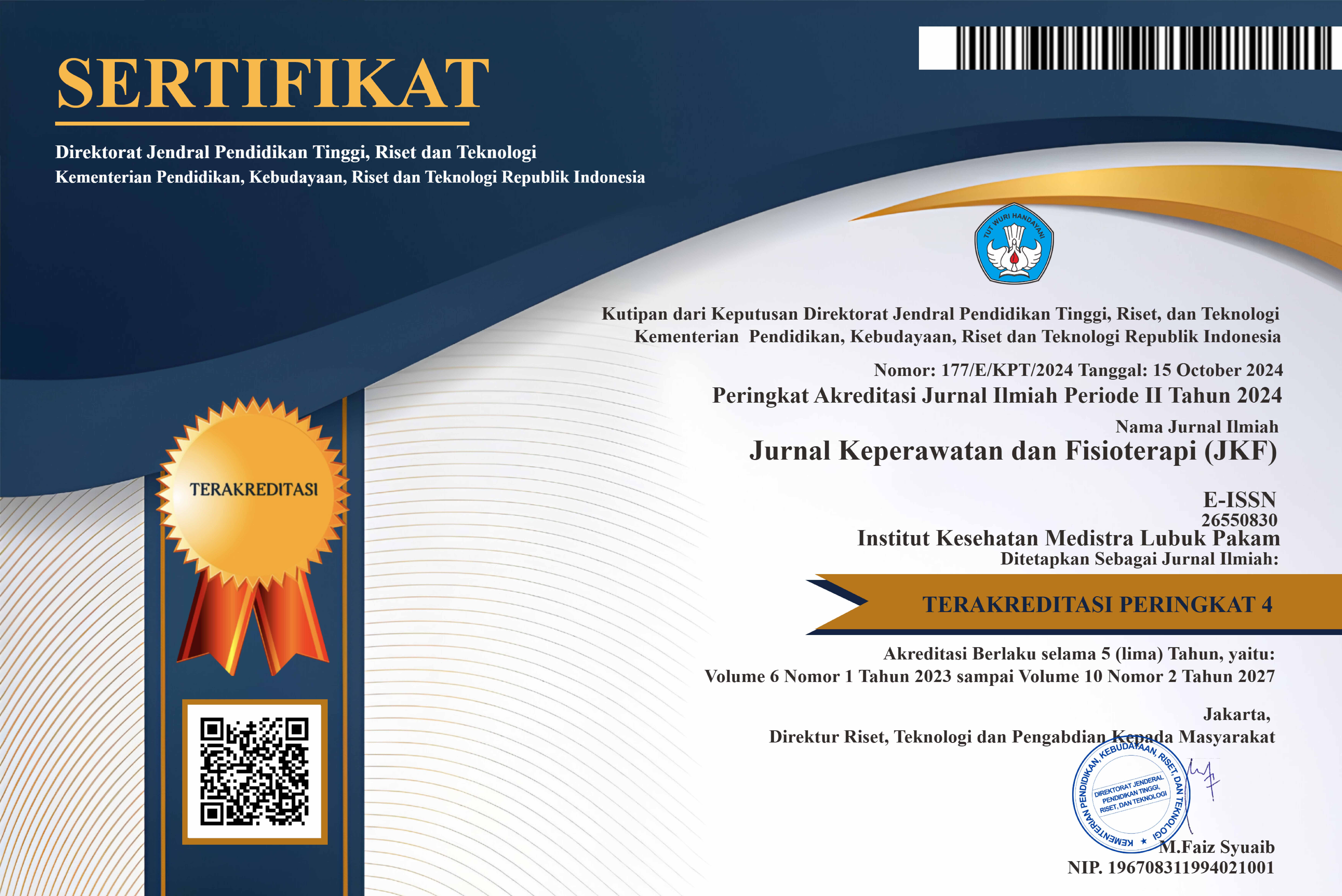Effect of Stabilization Exercise Improve Balance in Joint Degenerative Pain
DOI:
https://doi.org/10.35451/jkf.v5i2.1560Keywords:
nyeri, latihan stabilisasi, sendi degeneratif, keseimbanganAbstract
Increasing life expectancy and sedentary lifestyle in the elderly have an impact on physical changes, especially degenerative joint disease. Exercise is a modality that can provide physiological and therapeutic effects so that it can prevent, treat, and improve the quality of health. However, to find an exercise design that has the desired therapeutic effect requires a long journey and in-depth study. Many recent studies have shown that exercise initiates the secretion of proteins and tissue regeneration hormones which are very necessary for anti-aging in the elderly. The purpose of this study is to further enrich the exercise design which can be used as a reference for the high-risk elderly population and the elderly in general so that the quality of life and life expectancy are getting longer. The research method used pre and post design experimental studies through the purposive sampling technique method which was divided into 4 groups consisting of the control group, experimental group 1 and experimental group 2 which were carried out in August-October 2022 at Balai Warga RT 08 Kembangan Village, West Jakarta. Samples that met the inclusive and exclusion criteria were obtained by 18 respondents. To determine the range of motion and balance function assessment, the sample was measured with a range of motion and balance test instrument. Data were analyzed using a paired sample t-test to determine the effect of stabilization exercises on joint motion and balance function. Statistical test results p=0,001, (p<0,05) experimental first group and p=0,011, (p<0,05) experimental second group showed that there was a significant difference in the experimental groups 1 and 2 but there was no difference in the balance function p=0,414, (p>0.05). The conclusion is that stabilization exercises affect the range of motion in degenerative joint pain.
Downloads
References
Afonso J, Ramirez-Campillo R, Moscão J, Rocha T, Zacca R, Martins A, Milheiro AA, Ferreira J, Sarmento H, Clemente FM. (2021). Strength Training versus Stretching for Improving Range of Motion: A Systematic Review and Meta-Analysis. Healthcare (Basel), 9(4):427. doi: 10.3390/healthcare9040427.
Guliya, S., Chahal, A., & Samuel, A. J. (2021). Efficacy of core stability and supervised hip strengthening on knee osteoarthritis: a Randomized study protocol. Revista Pesquisa Em Fisioterapia, 11(4), 823–832. https://doi.org/10.17267/2238-2704RPF.V11I4.3972
Hsu, M., Hsieh, C., & Chiu, A. (2022). Factors Affecting Physical Activity of People with Knee Osteoarthritis in Southern Taiwan : A Multiple Logistic Regression Analysis. International Journal of Clinical Practice, 2022.
Huang, D., Liu, Y. Q., Liang, L. S., Lin, X. W., Song, T., Zhuang, Z. G., Wang, S. L., Bao, H. G., Wang, L., Zhang, X. W., Cheng, Z. G., Duan, B. L., Qiu, W. D., Xiong, Y. C., & Liu, J. F. (2018). The Diagnosis and Therapy of Degenerative Knee Joint Disease: Expert Consensus from the Chinese Pain Medicine Panel. Pain Research and Management, 2018. https://doi.org/10.1155/2018/2010129
Jarecki, J., Polkowska, I., Kazimierczak, W., Magdalena, W., Sowa, I., Dresler, S., & Blicharski, T. (2023). Assessment of the Impact of Physical Activity on the Musculoskeletal System in Early Degenerative Knee Joint Lesions in an Animal Model. International Journal of Molecular Science.
Joshi, S. M., Sheth, M. S., & Jayswal, M. M. (2019). Correlation of core muscles endurance and balance in subjects with osteoarthritis knee. International Journal of Medical Science and Public Health, 8(5), 347–351.
Litwic, A., Registrar, S., Edwards, M., & Clinical, M. (2013). Europe PMC Funders Group Epidemiology and Burden of Osteoarthritis. 44(0), 185–199. https://doi.org/10.1093/bmb/lds038.Epidemiology
Liu C, Wan Q, Zhou W et. al .(2017) Factors associated with balance function in patients with knee osteoarthriti : an integrative review. https://doi.org/10.1016/j.ijnss.2017.09.002
Parveen, S., Mahmood, T., & Khizer, M. (2019). Romberg test is a good indicator to reflect the performance of functional outcomes measure among elderly. International Journal of Health and Rehabilitation Sciences, 8(2), 67–76.
Sá-Caputo, D., Paineiras-Domingos, L. L., Francisca-Santos, A., Dos Anjos, E. M., Reis, A. S., Neves, M. F. T., Oigman, W., Oliveira, R., Brandão, A., Machado, C. B., Chiementin, X., Taiar, R., Sartório, A., & Bernardo-Filho, M. (2019). Whole-body vibration improves the functional parameters of individuals with metabolic syndrome: An exploratory study. BMC Endocrine Disorders, 19(1), 1–11. https://doi.org/10.1186/s12902-018-0329-0
Silva, L. E., Valim, V., Pessanha, A. P. C., Oliveira, L. M., Myamoto, S., Jones, A., & Natour, J. (2008). Hydrotherapy versus conventional land-based exercise for the management of patients with osteoarthritis of the knee: A randomized clinical trial. Physical Therapy, 88(1), 12–21. https://doi.org/10.2522/ptj.20060040
Toivanen, A. T., Heliövaara, M., Impivaara, O., Arokoski, J. P. A., Knekt, P., Lauren, H., & Kröger, H. (2010). Obesity, physically demanding work and traumatic knee injury are major risk factors for knee osteoarthritis-a population-based study with a follow-up of 22 years. Rheumatology, 49(2), 308–314. https://doi.org/10.1093/rheumatology/kep388
Downloads
Published
Issue
Section
License
Copyright in each article is the property of the Author.


























